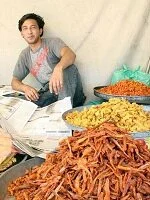
Food for Sale
Among most Indians education is an important aspect of life. Most schools start at about the same time as the workday begins, but most schools finish at 1:00 pm. Higher education is also growing in importance, especially for the technical jobs that are quickly growing, particularly India remains a location for foreign investment.
No matter the lifestyle and culture in India, the people seem to focus on family and children as many couples have a few children. No matter the wealth of a couple, having children is essential to Indians and often times three or more generations live under the same roof. In some cases the working aged adults support the entire family financially, while the other family members maintain the house and help raise the children. Of course this is India, so there is no standard or normal.
Identity
Most people in India tend to identify as either a member of their local ethnicity, of which there are hundreds or as a member of their religion, of which there are dozens. This sense of identity is truer in more rural areas as each many towns are home to people of a single ethnicity, language, and perhaps even a unique religion. This diversity is great from town to town, city to city, and region to region. This tendency to identify on an ethnic, linguistic, and religious level is somewhat limited to people who are more static. For many young people, especially those who have moved to a large city, identity is a bit vaguer. As many people move to cities, some places are forming melting pots of ethnicities, languages, and cultures. For these people and the next generation, it is more common to identify on a larger scale, whether than be as a member of the city, region, or even the country. In this way, many of the educated youth are shedding the caste system and viewing themselves as "Indians" in the global landscape, although many people still cling to their ethnicity on some level.